Motion planning via visibility graph: Point robot moving among polygonal obstacles in 2D
One of the fundamental problems in robotics is motion planning:
given a robot R and an environment (or physical space), a
start position pstart and an end position
pend, find a path so that the robot can move from
start to end, without collisisons.
Sometimes, depending on the problem, we might want the shortest
path from pstart to pend;
other times just a path (not necessarily the shortest) may be
sufficient.
General motion planning is difficult. We'll make the following
(simplifying) assumptions:
- 2D: We'll look at the 2-dimensional motion planning problem: we'll
assume that the environment consists of a set of 2D polygons that
represent the obstacles; and the robot is a 2D-polygon (convex or
not) and does not have joints (i.e. not an articulated robot).
Furthermore, we assume that the robot is moving in a large bounding
box B that contains all polygons.
- Static: We'll assume that the environment is static (the
obstacles are fixed).
- Known: The environment is known, i.e. the robot knows the
list of obstacles with their vertices and edges. That is, the robot
does not rely on sensors to learn the environment, instead the
environment is given.
Notation: we'll assume that the obstacles consist of n
edges. So for us O(n) represents the complexiy of the
obstacles (vertices plus edges).
Motion planning with a roadmap
The general idea of motion planning is to start by computing a
decomposition of the free space (the space where the robot can
move) into cells, and construct a road map of the free space to
guide the motion between neighboring cells. The road map is
essentially a graph of free space. Ideally we want to build the
roadmap so that so that:
- Any path in the road map corresponds to a collision-free path in the free space.
- Any path in the free-space corresponds to a path in the road map.
If we are able to compute a road map of free space with these
properties, then to move from s to t, we find a path
in the road map from s to t. We know that any path
in the road map is colision-free (by (1)), and we know that if a path
in the road map does not exist, then no path exists (by (2)).
Essentially we have reduced the motion planning problem to a path
problem in a graph.
Different types of motion planning problems will require different types of roadmaps.
The simplest problem is a point robot moving among polygonal
obstacles in 2D.
Two types of roadmaps are used:
Trapezoidal decomposition: The free space can be
decomposed as follows: from each vertex, shoot a vertical ray above
and below, until it intersects with an edge (or the bounding box
B). This is called a
trapezoidal decomposition, and we have seen something very
similar when we talked about polygon triangulation; in this case we
have a set of polygons, not just one, but the idea is the same. This
trapezoidal decomposition can be computed using standard
techniques. Each trapezoid corresponds to a region of the free
space. To guide movement between adjacent trapezoids, we can construct
a road map as follows: we place one node in the center of each
trapezoid, and we place one node in the middle of each vertical
edge. There is an arc between two nodes if and only iff one node is in
the center of a trapezoid and the other node is on the boundary of
that same trapezoid. The figure below illustrates this (from 4M
book). A path from start to end can be found via BFS in the road
map. It can be shown that the road map has linear complexity
O(n), which is good. But, paths obtained with this approach
are not necessarily shortest.
In summary, the roadmap idea is a useful thing to remember in general,
but in the simple case of a point robot moving in 2D, we can do
better.
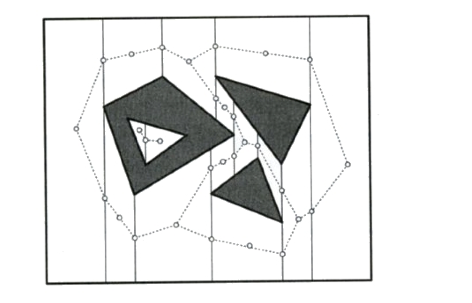
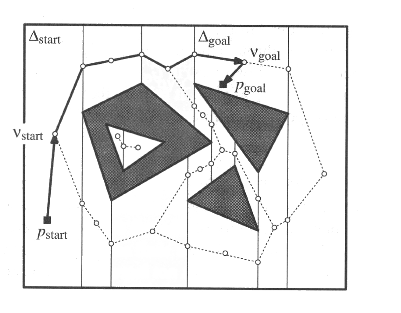
The visibility graph: A different type of road map that can
be used for finding shortest paths is the visibility graph:
this is a graph whose vertices are the vertices of the obstacles, and
its edges (u,v) are all the pair of vertices that can "see"
each other, that is, segment uv does not intersect the
interior of any obstacle. Below are some screenshots (the first screenshot is from
http://www.cs.cmu.edu/afs/cs.cmu.edu/academic/class/16311/www/s06/lecture/lec8.html).
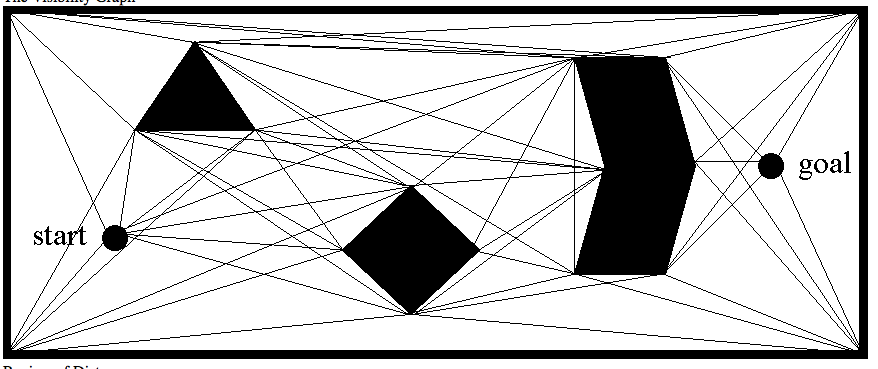
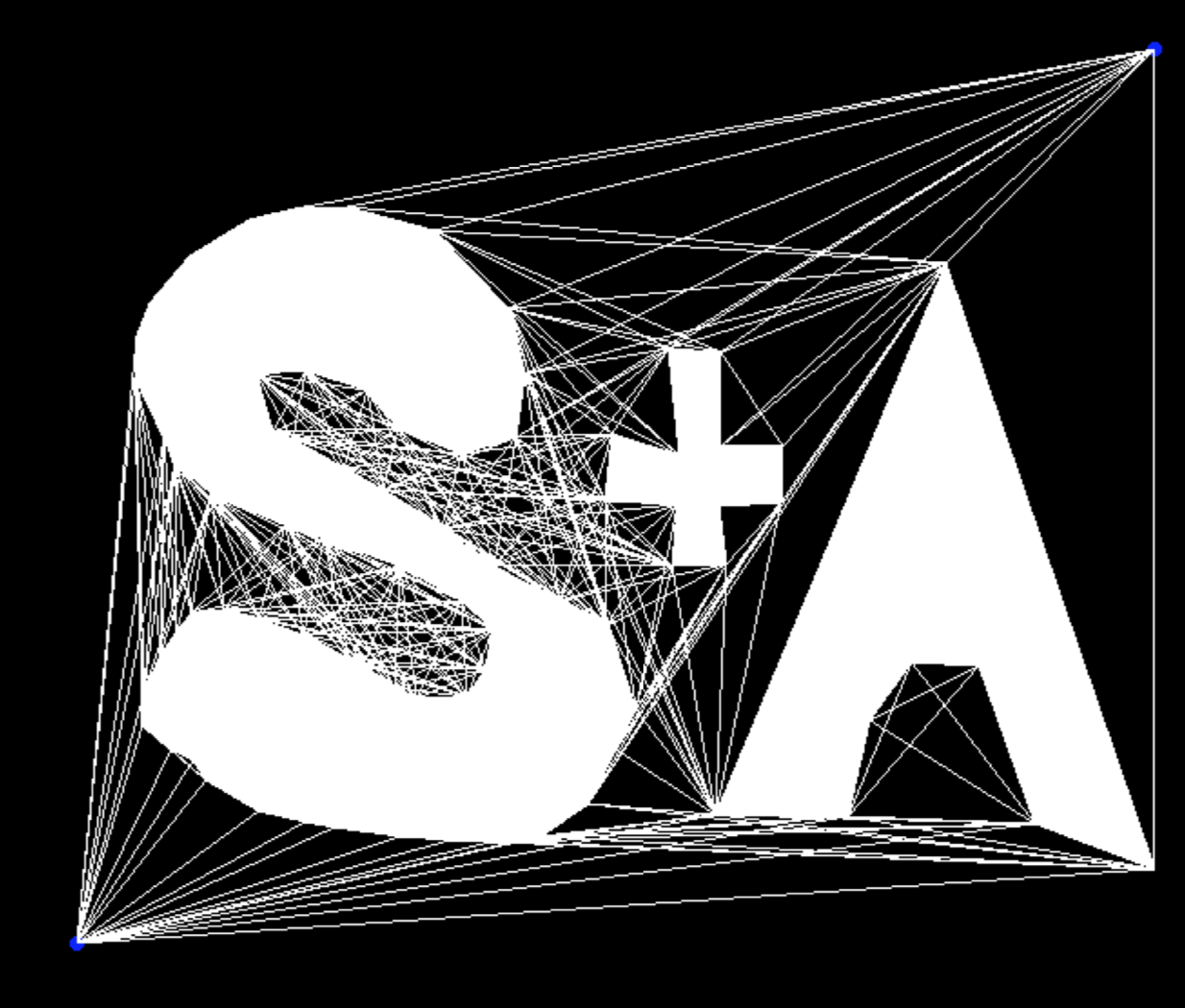
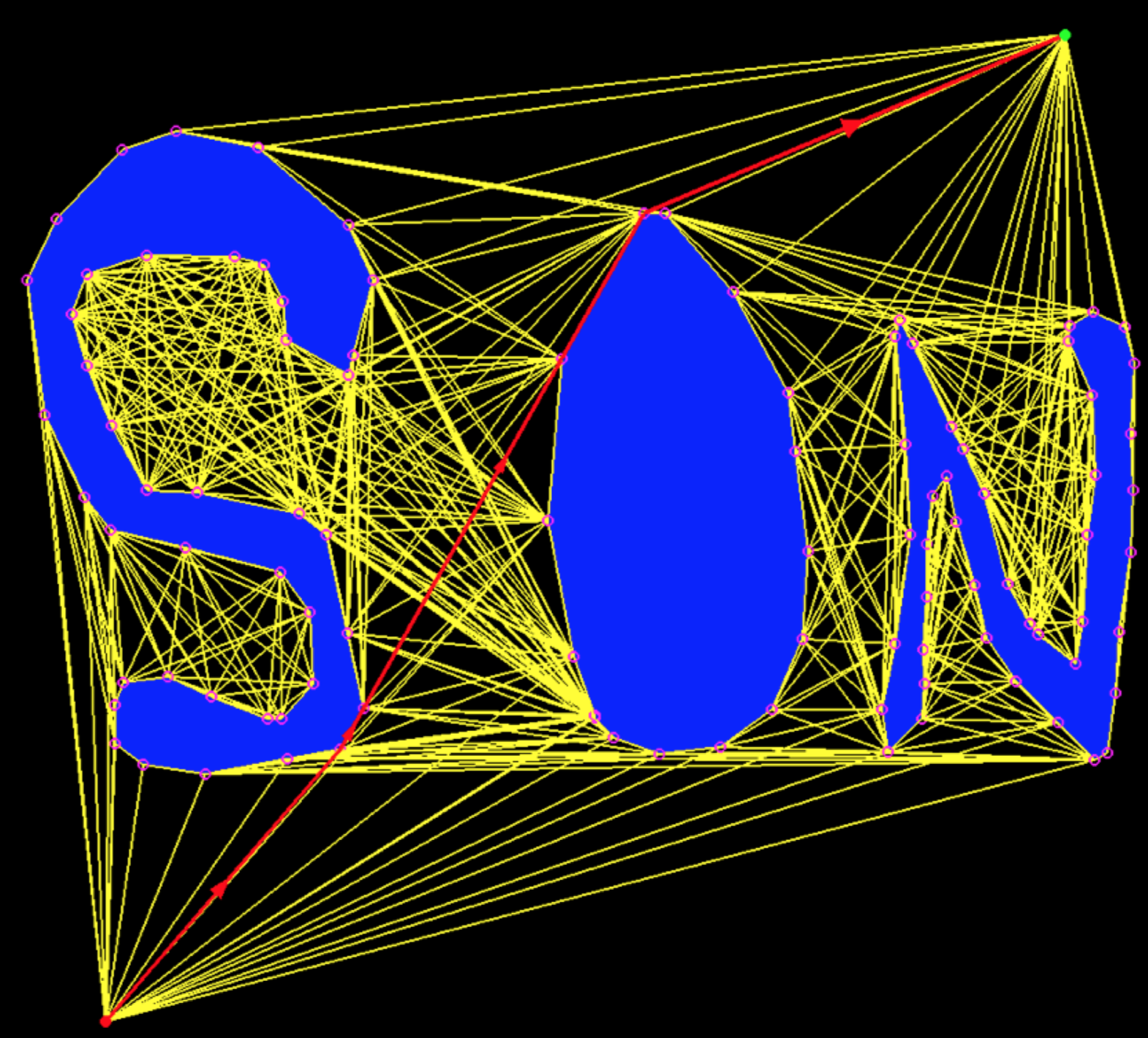
Shortest paths in 2D have the very nice and convenient property that
they are straight lines, and they have to go through the vertices of
the obstacles. This basically means that any shortest path will be
contained in the VG. Once the visibility graph (VG) is computed, the
shortest paths from start to end can be computed for e.g. using
Dijkstra's algorithm.
Perspective: The problem with the VG approach is that the VG may
have quadratic complexity in the worst case, and any approach that
computes the whole VG is doomed to quadratic complexity. It would be
nice to compute the shortest path from s to t on the
fly, without using at least quadratic time and space to compute and
store the VG.This was an open problem for a while; the quadratic
barier was first broken by Joe Mitchell, and subsequently Hershberger
and Suri (1993) described an optimal (n lg n) algorithm called the
continuous Dijkstra algorithm. Feel free to search if you are
curious.
This assignment: Motion planning via VG for a point robot moving among
polygonal obstacles in 2D
- Generate a scene consisting of multiple polygonal obstacles and
a start and end position. Have a pre-set scene, but also allow the
user to enter the obstacles by clicking the mouse.
- Compute and render the visibility graph.
- Run Dijkstra's algorithm on the VG and render the resulting path
(for e.g. in a different color and different line width).
Extra features
- Implement a point-in-polygon method and use it to detect if start or end points are inside an obstacle.
- Detect if a polygon is self-intersecting.
- Detect if polygons are overlapping.
- Draw the polygons filled. Note that openGL can only fill
correctly convex polygons, so if you want it filled, you'll need to
provide a triangulation.
What to turn in
- push your code in your github repo
- you will fill a self report in class
Enjoy!
Grading
- +50 points: find al edges in VG, no more, no less (no missing edges, no extraneous edges)
- +20 points: compute shortest path and display it
- +10: the user is able to click and select new start and end positions
Code Style: 20 points
- +0-10 points: poor to medium code.
- +10-20 points: medium to excellent code.




